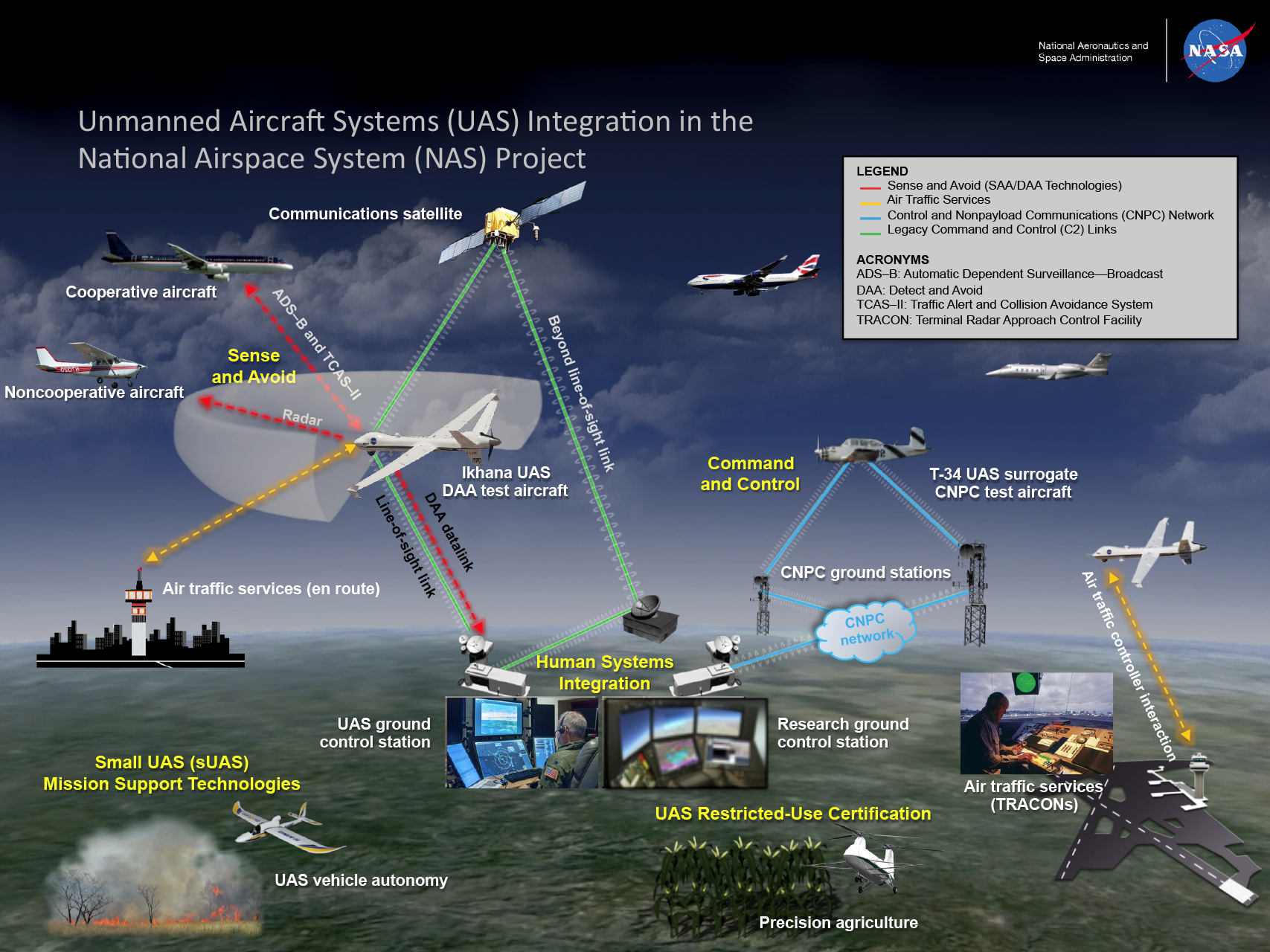Editor’s note: The UAS in the NAS project was concluded in September 2020. This material is being kept online for historical purposes, but it will no longer be updated.
There is an increasing need to fly Unmanned Aircraft Systems (UAS) in the National Airspace System (NAS) to perform missions of vital importance to national security and defense, emergency management, science, and to enable commercial applications. However, routine access by UAS to the NAS remains unrealized.
The UAS community needs routine access to the global airspace for all classes of UAS. Based on this need, NASA’s UAS Integration in the NAS Project identified the following goal: To provide research findings to reduce technical barriers associated with integrating UAS into the NAS utilizing integrated system level tests in a relevant environment.
NASA Armstrong is host to the UAS Integration in the NAS (UAS-NAS) project office. The Project is supported by the NASA Aeronautics Centers at Ames Research Center, Armstrong Flight Research Center, Glenn Research Center, and Langley Research Center. This project is scheduled to be complete by the end of 2020. UAS-NAS is a vital mission that provides research findings through simulations and flight tests, to support the development and validation of Detect and Avoid (DAA) and Command and Control (C2) technologies necessary for integrating unmanned aircraft systems.
Current Status
The DAA minimum operational performance standards (MOPS) development is supported through the collection of data through human in the loop simulations and flight tests. During FY 2019, the project plans to complete flight test series 6 that will use DAA technology (radar sensor) on a medium size UAS to detect and avoid other aircraft in a controlled environment. The test data will provide input to a MOPS revision (the original MOPS was developed for large UAS that could support a larger radar sensor suite). This flight test series will be completed by the end of 2019.
The C2 MOPS standards development will be updated through project tests using a smaller C2 radio and update the next version of the C2 MOPS. The C2 testing will be completed by the end of 2019.
The Systems Integration and Operationalization (SIO) demonstrations are planned for the July 2020 timeframe and will be conducted by our SIO partners. The partners were selected using a cooperative agreement. They are PAE ISR flying their Resolute Eagle at the Pendleton Oregon UAS Test Site for pipeline inspection. Bell Helicopter flying their APT-70 in Texas for medical deliveries. General Atomics flying their Sky Guardian in Southern California for a series of missions over various sites.
All of the activities above will promote the integration of UAS into the NAS by developing standards necessary to allow Industry to certify their technology and stimulate Industry through the SIO partnerships to move forward with certification.
History
NASA continues to address UAS-NAS integration technical challenges under the UAS-NAS Project. This project was initiated within the Integrated Aviation Systems Program of the Aeronautics Research Mission Directorate in 2010. The UAS-NAS Project approach was to contribute research findings to reduce technical barriers related to the safety and operational challenges associated with enabling routine UAS access to the NAS in technology areas aligned with current NASA expertise and capabilities. The Project consists of two phases, with Phase 1 occurring from FY11 – FY16 and Phase 2 from FY17 – FY20.
Phase 1 included development and integration of system-level key concepts, technologies, and procedures based on UAS stakeholder and community needs collected during UAS-NAS Project formulation. This phase also included refinement of those needs as part of defining the specifics of the Phase 1 research portfolio. In a latter part of Phase 1 research activities were continued in a modified research portfolio. The Project included demonstration of the integrated technologies in operationally-relevant environments. The technology areas selected included DAA, C2, human systems integration, and integrated test and evaluation for live, virtual, constructive – distributed environment development. This research was accomplished considering existing NASA expertise and capabilities but also FAA, RTCA Special Committee 228 (SC-228), and UAS community research needs. By using a rigorous research selection process, the contribution of the Project Phase 1 research activities contributed to the development of SC-228 Phase 1 Final DAA, air to air radar, and C2 data link MOPS, as well as providing foundational research associated with full integration of UAS into the NAS.
The UAS-NAS Project continues to provide research findings to RTCA SC-228 to develop and validate SC-228 Phase 2 MOPS for DAA performance and interoperability and for terrestrial C2. The Project is more than halfway through conducting a series of tests in this phase, evaluating the technologies in test environments representing the NAS. To facilitate the transition of the research findings to the stakeholders, the UAS-NAS Project continues to emphasize partnerships and collaborations.
These activities support research within the aeronautics strategic thrust area 6.
A Civil Future for Unmanned Aircraft Systems































